Kelvin Smith Library
For more information about Case School of Law faculty authors, please visit Case Law Library's research guide.
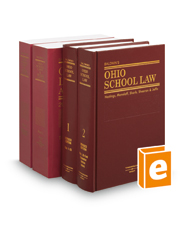 Baldwin's Ohio School Law (Rev. ed) by W. Michael Hanna, Susan C. Hastings, Daniel A. Jaffe, Richard D. Manoloff, Michael L. Sharb, Timothy J. Sheeran, and Gregory W. Stype
Baldwin's Ohio School Law (Rev. ed) by W. Michael Hanna, Susan C. Hastings, Daniel A. Jaffe, Richard D. Manoloff, Michael L. Sharb, Timothy J. Sheeran, and Gregory W. Stype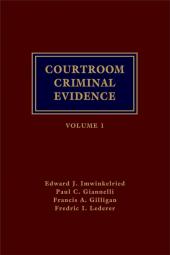 Courtroom Criminal Evidence (6th ed.) by Edward J. Imwinkelried, Paul C. Giannelli, Francis A. Gilligan, Fredric I. Lederer, Liesa Richter
Courtroom Criminal Evidence (6th ed.) by Edward J. Imwinkelried, Paul C. Giannelli, Francis A. Gilligan, Fredric I. Lederer, Liesa Richter Courtroom Criminal Evidence (6th ed.) by Edward J. Imwinkelried, Paul C. Giannelli, Francis A. Gilligan, Fredric I. Lederer, Liesa Richter
Courtroom Criminal Evidence (6th ed.) by Edward J. Imwinkelried, Paul C. Giannelli, Francis A. Gilligan, Fredric I. Lederer, Liesa Richter Courtroom Criminal Evidence (6th ed.) by Edward J. Imwinkelried, Paul C. Giannelli, Francis A. Gilligan, Fredric I. Lederer, Liesa Richter
Courtroom Criminal Evidence (6th ed.) by Edward J. Imwinkelried, Paul C. Giannelli, Francis A. Gilligan, Fredric I. Lederer, Liesa Richter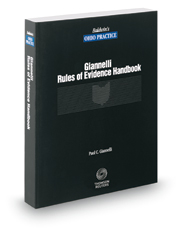 Giannelli Rules of Evidence Handbook (2016 ed.) by Paul C. Giannelli
Giannelli Rules of Evidence Handbook (2016 ed.) by Paul C. Giannelli Giannelli Rules of Evidence Handbook (2017 ed. Baldwin's Ohio practice series) by Paul C. Giannelli
Giannelli Rules of Evidence Handbook (2017 ed. Baldwin's Ohio practice series) by Paul C. Giannelli Giannelli rules of evidence handbook (2018 ed. Baldwin's Ohio practice series) by Paul C. Giannelli
Giannelli rules of evidence handbook (2018 ed. Baldwin's Ohio practice series) by Paul C. Giannelli Katz & Giannelli Ohio Criminal Laws and Rules (2016 ed.) by Lewis R. Katz and Paul C. Giannelli
Katz & Giannelli Ohio Criminal Laws and Rules (2016 ed.) by Lewis R. Katz and Paul C. Giannelli Katz & Giannelli Ohio criminal laws and rules (2017 ed. Baldwin's Ohio Practice Series) by Lewis R. Katz and Paul C. Giannelli
Katz & Giannelli Ohio criminal laws and rules (2017 ed. Baldwin's Ohio Practice Series) by Lewis R. Katz and Paul C. Giannelli Katz & Giannelli Ohio criminal laws and rules (2018 ed. Baldwin's Ohio Practice Series) by Lewis R. Katz and Paul C. Giannelli
Katz & Giannelli Ohio criminal laws and rules (2018 ed. Baldwin's Ohio Practice Series) by Lewis R. Katz and Paul C. Giannelli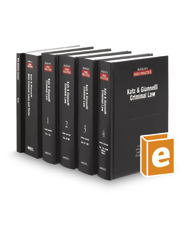 Katz Giannelli criminal law (3rd ed) by by Lewis R. Katz, Paul C. Giannelli, Beverly J. Blair, and Judith P. Lipton
Katz Giannelli criminal law (3rd ed) by by Lewis R. Katz, Paul C. Giannelli, Beverly J. Blair, and Judith P. Lipton Katz Giannelli criminal law (3rd ed) by by Lewis R. Katz, Paul C. Giannelli, Beverly J. Blair, and Judith P. Lipton
Katz Giannelli criminal law (3rd ed) by by Lewis R. Katz, Paul C. Giannelli, Beverly J. Blair, and Judith P. Lipton Katz Giannelli Criminal Law (3rd ed) by Lewis R. Katz, Paul C. Giannelli, Beverly J. Blair, and Judith P. Lipton
Katz Giannelli Criminal Law (3rd ed) by Lewis R. Katz, Paul C. Giannelli, Beverly J. Blair, and Judith P. Lipton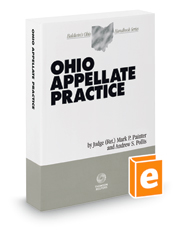 Ohio Appellate Practice (2016-2017 ed.) by Mark P. Painter and Andrew S. Pollis
Ohio Appellate Practice (2016-2017 ed.) by Mark P. Painter and Andrew S. Pollis Ohio Appellate Practice (Annually 2017-2018 ed.) by Mark P. Painter and Andrew S. Pollis
Ohio Appellate Practice (Annually 2017-2018 ed.) by Mark P. Painter and Andrew S. Pollis Ohio Appellate Practice (Annually 2018-2019 ed.) by Mark P. Painter and Andrew S. Pollis
Ohio Appellate Practice (Annually 2018-2019 ed.) by Mark P. Painter and Andrew S. Pollis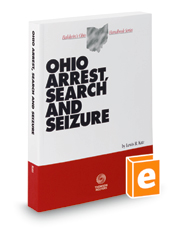 Ohio Arrest, Search and Seizure (2016 ed.) by Lewis R. Katz
Ohio Arrest, Search and Seizure (2016 ed.) by Lewis R. Katz Ohio Arrest, Search and Seizure (2017 ed.) by Lewis R. Katz
Ohio Arrest, Search and Seizure (2017 ed.) by Lewis R. Katz Ohio Arrest, Search and Seizure (2018 ed.) by Lewis R. Katz
Ohio Arrest, Search and Seizure (2018 ed.) by Lewis R. Katz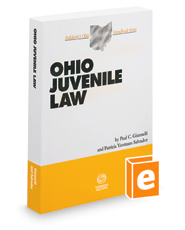 Ohio Juvenile Law (2016 ed.) by Paul C. Giannelli and Patricia Yeomans Salvador
Ohio Juvenile Law (2016 ed.) by Paul C. Giannelli and Patricia Yeomans Salvador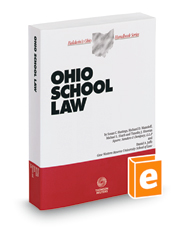 Ohio School Law (2016-2017 ed.) by Susan C. Hastings, Daniel A. Jaffe, Richard D. Manoloff, and Michael L. Sharb
Ohio School Law (2016-2017 ed.) by Susan C. Hastings, Daniel A. Jaffe, Richard D. Manoloff, and Michael L. Sharb Ohio School Law (2017-2018 ed.) by Susan C. Hastings, Daniel A. Jaffe, Richard D. Manoloff, and Michael L. Sharb
Ohio School Law (2017-2018 ed.) by Susan C. Hastings, Daniel A. Jaffe, Richard D. Manoloff, and Michael L. Sharb Ohio School Law (2018-2019 ed.) by Susan C. Hastings, Daniel A. Jaffe, Richard D. Manoloff, and Michael L. Sharb
Ohio School Law (2018-2019 ed.) by Susan C. Hastings, Daniel A. Jaffe, Richard D. Manoloff, and Michael L. Sharb Problems in Evidence (6th ed.) by Robert Mosteller; Paul Giannelli; Kenneth Broun; Liesa Richter
Problems in Evidence (6th ed.) by Robert Mosteller; Paul Giannelli; Kenneth Broun; Liesa Richter Scientific Evidence (5th edition) by Edward J. Imwinkelried; Paul C. Giannelli; Andrea Roth; Jane Campbell Moriarty
Scientific Evidence (5th edition) by Edward J. Imwinkelried; Paul C. Giannelli; Andrea Roth; Jane Campbell Moriarty Scientific Evidence (5th edition) by Edward J. Imwinkelried; Paul C. Giannelli; Andrea Roth; Jane Campbell Moriarty
Scientific Evidence (5th edition) by Edward J. Imwinkelried; Paul C. Giannelli; Andrea Roth; Jane Campbell Moriarty Scientific Evidence (5th edition) by Edward J. Imwinkelried; Paul C. Giannelli; Andrea Roth; Jane Campbell Moriarty
Scientific Evidence (5th edition) by Edward J. Imwinkelried; Paul C. Giannelli; Andrea Roth; Jane Campbell Moriarty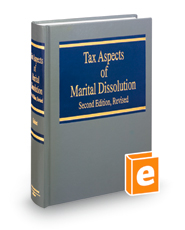 Tax Aspects of Marital Dissolution (2nd Rev. ed) by Leon Gabinet
Tax Aspects of Marital Dissolution (2nd Rev. ed) by Leon Gabinet Tax Aspects of Marital Dissolution (2nd Rev. ed) by Leon Gabinet
Tax Aspects of Marital Dissolution (2nd Rev. ed) by Leon Gabinet Tax Aspects of Marital Dissolution (2nd Rev. ed) by Leon Gabinet
Tax Aspects of Marital Dissolution (2nd Rev. ed) by Leon Gabinet